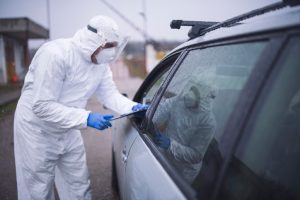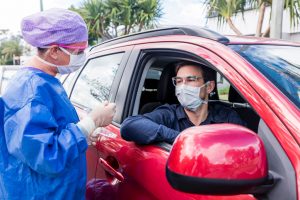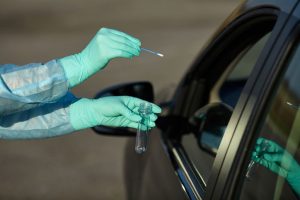The COVID-19 pandemic has gone through a strange pattern in the United States, surging to crisis levels in major urban centers like New York and New Orleans, then subsiding briefly before coming back hard and strong in more rural states like Alabama and Arizona. It’s a strong message that the virus is likely to be a persistent, whack-a-mole problem that’s going to rear its head the moment we relax our grip on it. And through it all, medical assistants will remain on the front lines of that battle around the country.
There’s a global consensus building around the importance of testing and tracing cases to minimize the spread. Although the United States is slow in building the political willpower for this proven-effective procedure, many local and regional public health agencies are ramping up for the massive scale of testing that will be needed to enable it.
The testing itself is a challenge, however, both in terms of volume and safety. The standard PCR (polymerase chain reaction) test used to detect SARS-CoV-2 infections requires inserting a sterile swab through the nose and deep into the nasopharyngeal passage to scoop out fluid that can then be analyzed. There’s nothing fun about it, and it requires close contact with a potentially infected patient which makes it risky for the healthcare staff who administer those tests, and for other patients in the testing facility.
Fortunately, there’s an option that borrows from the sensibilities of fast and seamless service, bringing the risks way down while speeding the whole process way up; and medical assistants could play a key role in it: drive-through testing.
Where Medical Assistants Fit Into Drive-Through COVID-19 Testing
The FDA’s recent decision to allow patients to self-administer swab testing under supervision was based on the simple realization that keeping people in their cars reduces much of the risk of cross-contamination between test subjects while reducing direct contact between provider and patient.
It makes testing faster and safer for everyone, but healthcare professionals are still needed to run the show. But because it’s a largely hands-off process now, it’s something that can be handled without having to pull skilled nurses and other healthcare professionals off the clinic floor where they’re most needed.
Testing sites can become a bit of a zoo, and the job of bringing some order to the chaos is one that often falls to medical assistants.
1. The Number One Most Likely Role for MAs is on the Periphery as the Drive-Through Screener

Screeners are the first staff in contact with the people coming in, but only light PPE is required because you won’t be getting too close! Instead, your job is to collect information and verify that the person is eligible for testing. At some sites, appointments are required, and if so, the screen verifies the person is on the schedule and checks off that they have arrived, while notifying the testing station that the next person to be tested is in the queue.
In other areas, testing remains limited and only people with possible symptoms, or who work in certain jobs are eligible. It will be your job to validate that before sending them on to the testing station, or, if they are not, directing them back out through the exit and providing information on how or when they will be eligible for testing.
Screeners may also be prepared to answer other questions about the testing process or even about COVID-19 in general since they will have the most interaction with patients.
The most important part of the job, though, is data collection. Personal information has to be collected so that the person can be contacted if the test comes back positive.
It’s a terrible feeling to get a positive test result back from the lab only to find that the person’s phone number is illegible or missing a digit – this happens more often than you might imagine. Many facilities are going with digital data collection to prevent this kind of thing from happening, so get your hunting and pecking fingers ready to handle an iPad for your twelve-hour shift!
2. The Prepper is Closer to the Action, Positioned at the Actual Testing Station

In some sites, where self-collection is used, the prepper and swabber roles are combined so only one person is stationed there.
At other sites, however, the prepper works as the clean side of the two-man team. That means you will only interact with sterile, non-contaminated supplies and tasks and only light PPE are required: a mask and gloves are probably fine.
The prepper handles all the test equipment preparation, unpacking the sterile swabs and collection and preservation of media tubes, laying out drapes, and putting labels on the test kit for processing. Part of the process is also a check on the screener; the prepper has to verify the personal information collected at the first step.
The prepper may also be responsible for safely packaging the test media after the swab has been collected and storing it in a refrigerator or getting to the lab via currier, depending on how the site is set up.
3. The Swabber is in the Thick of It, Working on the Dirty Side of the Testing Process

Handling potentially infectious materials and any necessary patient contact are the duties that fall to the swabber. Not all facilities will allow self-collection despite the fact that it’s approved by the FDA, so you may well find yourself playing nasal swizzle stick with patients. You’ll need to dress in full PPE for the event, including:
- Gown
- Gloves
- Goggles or face shield
- N95 respirator or close-fitting mask
Beyond the basic risk of infection with COVID-19, swabbers have to be prepared for other incidental clinical catastrophes… those inevitable errors where an errant swab triggers a nosebleed, or the provocation of the gag reflex initiates a vomit blast coming out the window. Being quick on your feet with an emesis basin and keeping a sterile drape handy can save you a lot of drama.
In places where self-collection is allowed, you’ll keep all the equipment but fall back to a less invasive role. In those cases, it will be your job to supervise the patient and ensure that they perform the procedure correctly themselves. You’ll still be the one taking the sample swab and packaging it in the transport media, as well as dealing with any procedural failures.
Taken together with traffic control, logistical support, and other facilities staff, these roles that medical assistants can fill make up the backbone of a drive-through testing effort. In the coming months, thousands and perhaps millions of Americans will filter through such test sites, coming away with peace of mind or access to the kind of life-saving medical care they may need to get through a COVID-19 infection.
And for MAs, well, you were saying you wanted to spend more time outside the office, right? Here’s your opportunity to finally have that outdoor job you have always wanted!



